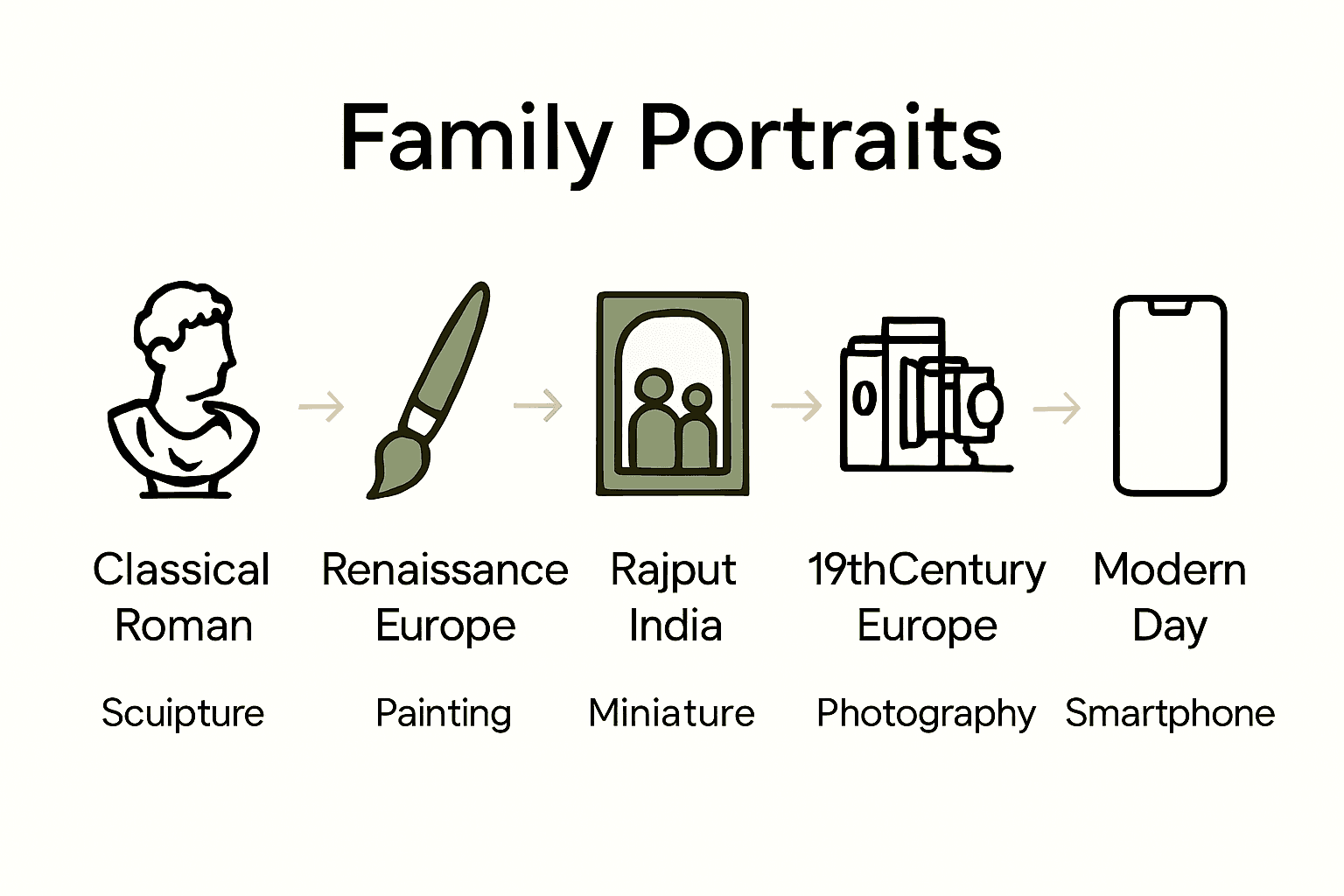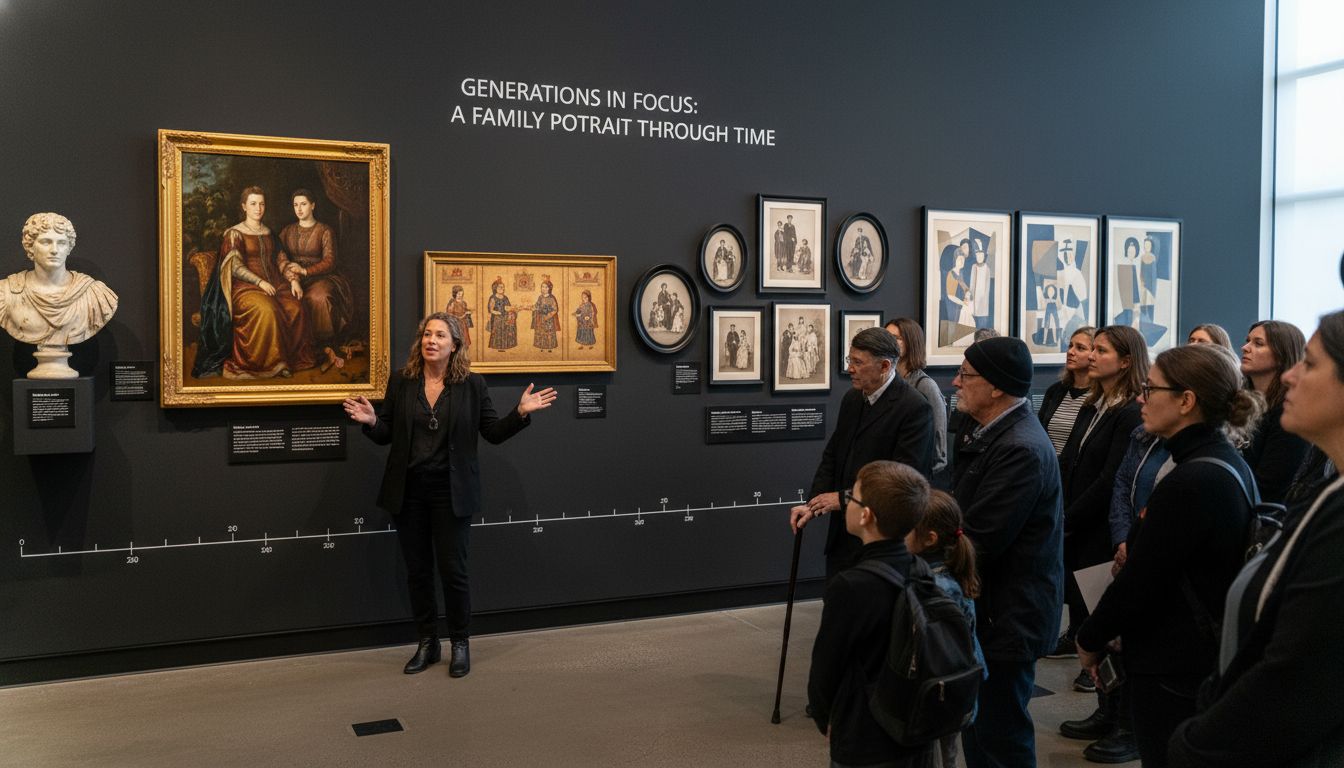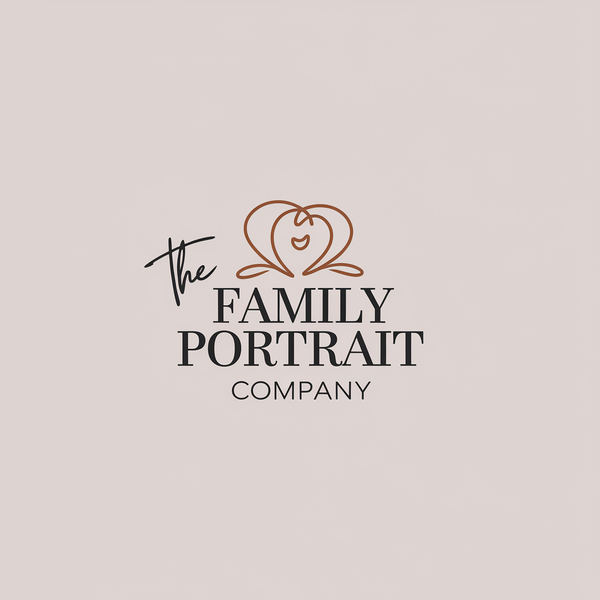
History of Family Portraits: Complete Guide for Families
Share
Did you know that over 80 percent of households in some countries display at least one family portrait in their home? Family portraits have shifted dramatically over time, evolving from exclusive painted images for the elite to everyday snapshots capturing the personalities and stories of modern families. These images do more than preserve faces—they reveal changing values, family structures, and social trends throughout history.
Table of Contents
- Defining Family Portraits Throughout History
- Major Styles and Artistic Periods Explained
- Cultural Influences on Family Portrait Traditions
- Famous Family Portraits and Their Impact
- Modern Family and Pet Portrait Trends
Key Takeaways
| Point | Details |
|---|---|
| Evolution of Family Portraits | Family portraits have transitioned from exclusive aristocratic paintings to accessible photographs, reflecting societal changes and technological advancements. |
| Cultural Significance | Family portraits serve as cultural artifacts, embodying unique values and dynamics across different societies and historical periods. |
| Contemporary Trends | Modern family portraits embrace authenticity and inclusivity, often including pets, and focus on creating emotional connections rather than just documenting appearances. |
| Artistic Legacy | Historical family portraits have influenced contemporary styles, encouraging photographers to capture the essence of family bonds through diverse and innovative compositions. |
Defining Family Portraits Throughout History
Family portraits represent far more than simple photographs or paintings - they are powerful visual narratives capturing the essence of familial relationships, societal structures, and cultural dynamics. According to research from arxiv.org, family portraits have dramatically transformed from formal painted representations to personal photographic collections, reflecting profound societal changes and technological advancements.
Historically, family portraits were exclusive privileges reserved for wealthy aristocratic and upper-class families who could afford commissioned paintings by professional artists. These early portraits were meticulously crafted representations that communicated social status, familial lineage, and personal wealth. Subjects would be carefully posed, wearing their most elaborate clothing, with specific backgrounds and props strategically selected to enhance their perceived social standing.
As photographic technology emerged in the mid-19th century, family portraiture became increasingly democratised. Technological innovations made capturing family images more accessible and affordable for middle-class households. arxiv.org research suggests that these evolving portrait practices provide remarkable insights into cultural norms and shifting familial structures. The transition from painted to photographic portraits marked a significant cultural shift, enabling more people to document and preserve their family histories.
Today, family portraits continue to serve multiple purposes beyond mere documentation. They are emotional archives, preserving memories, celebrating relationships, and creating tangible connections across generations. Whether a formal studio session, a casual outdoor shoot, or a candid smartphone snapshot, exploring unique family portrait themes can help families create lasting visual legacies that tell their unique stories.
Major Styles and Artistic Periods Explained
Family portraiture has been a powerful artistic medium across diverse cultural and historical contexts, reflecting the aesthetic sensibilities and social dynamics of different eras.
Here’s a comparison of key family portrait styles across historical periods:

| Period | Typical Medium | Main Features | Symbolic Purpose |
|---|---|---|---|
| Classical (Ancient Rome) | Sculpture Painted Fresco |
Idealised figures Formal arrangement |
Demonstrate virtue Political status |
| Renaissance | Oil Painting | Lifelike detail Symbolic elements |
Showcase power Family lineage |
| Rajput (18th Century India) | Miniature Painting | Intricate detail Vibrant colours |
Royalty Cultural tradition |
| 19th Century Europe | Early Photography Painting |
Formal poses Staged studio settings |
Social status Family unity |
| 20th Century to Present | Modern Photography | Candid moments Diverse configurations |
Emotional connection Diversity |
In the Renaissance, family portraits transitioned from purely representational to deeply symbolic artworks. Wealthy European families commissioned intricate paintings that not only captured physical likenesses but also metaphorically represented familial power, lineage, and economic status. Artists like Rembrandt and Velázquez elevated family portraiture from simple documentation to complex narrative art, embedding subtle symbolic elements that spoke to the family’s social positioning.
Wikipedia provides fascinating insights into cultural variations, noting that in 18th-century India, Rajput painting emerged as a remarkable tradition of royal family portraiture. These paintings were characterized by intricate details, vibrant colours, and complex compositional techniques that went far beyond mere visual documentation. Each portrait was a carefully constructed narrative, revealing not just individual appearances but entire cultural and familial ecosystems.
The 20th century witnessed a dramatic transformation in family portraiture, moving from formal studio settings to more candid, authentic representations. Technological advancements in photography democratized the process, allowing families from all social backgrounds to capture and preserve their memories. Modern family portraits now embrace diversity, spontaneity, and personal expression, reflecting our contemporary understanding of familial relationships as dynamic, complex, and deeply personal. exploring unique family portrait themes can help families capture these evolving narratives in creative and meaningful ways.

Cultural Influences on Family Portrait Traditions
Family portraits are far more than simple images - they are complex cultural artifacts that reflect the nuanced social dynamics, values, and aesthetic sensibilities of different societies. Each culture develops its unique approach to representing familial relationships, transforming portraiture into a rich visual language that communicates deep societal meanings. Artistic representation varies dramatically across different regions, each embedding unique cultural narratives within seemingly simple family images.
In the Middle East, for instance, Wikipedia highlights how Qajar art in Iran produced distinctive family portraits that beautifully demonstrated cultural synthesis. These portraits ingeniously blended traditional Persian artistic elements with emerging European influences, creating a visual dialogue that represented the complex cultural transitions of the era. Such portraits were not merely decorative but served as powerful statements about identity, modernization, and cultural negotiation.
Wikipedia provides fascinating insights into how family portraits can reflect broader societal transformations. The exhibition ‘Facing the Modern: The Portrait in Vienna 1900’ revealed how Viennese family portraits captured the profound social changes occurring at the turn of the century. These portraits were more than personal keepsakes - they were visual narratives documenting shifts in family structures, gender roles, and social expectations during a period of significant cultural upheaval.
Today, family portrait traditions continue to evolve, embracing diversity, personal expression, and technological innovations.
Different cultures now blend traditional artistic approaches with contemporary sensibilities, creating portraits that are simultaneously deeply personal and universally meaningful. how to personalize family portraits can help families navigate these rich cultural traditions, ensuring their unique stories are captured with authenticity and creativity.
Famous Family Portraits and Their Impact
Family portraits have long been more than simple visual records - they are profound artistic statements that capture the complex dynamics of human relationships, social structures, and cultural identities. Throughout art history, certain family portraits have transcended their original context to become iconic representations that reshape our understanding of familial connections and societal norms.
In the realm of baroque art, E Harris Gallery highlights Diego Velázquez’s masterpiece ‘Las Meninas’ (1656) as a revolutionary family portrait. This intricate painting of the Spanish royal family goes far beyond conventional portraiture, creating a complex visual narrative that challenges traditional perspectives. Velázquez ingeniously included himself in the painting, blurring the lines between subject, artist, and viewer, and transforming the concept of what a family portrait could represent.
Wikipedia draws attention to Frans Hals’ ‘Family Group in a Landscape’ (c. 1645-1648), which marked a significant departure from stiff, formal portraiture. Hals introduced a revolutionary approach to group portraiture, capturing families with unprecedented dynamism and emotional authenticity. His work demonstrated that family portraits could be vibrant, spontaneous representations of familial relationships, rather than static, staged compositions.
Modern family portraits continue this legacy of storytelling and emotional depth. Today’s photographers and artists draw inspiration from these historical masterpieces, creating images that capture not just physical likenesses but the essence of familial bonds. understanding family portrait sessions can help families appreciate the profound artistic and emotional potential of their own family portraits, transforming them from mere photographs to lasting historical narratives.
Modern Family and Pet Portrait Trends
The landscape of family portraiture has undergone a remarkable transformation, reflecting the dynamic and diverse nature of contemporary family structures. Family portraits are no longer confined to traditional staged photographs, but have evolved into deeply personal, authentic representations that celebrate individual uniqueness and emotional connections.
According to research from arxiv.org, contemporary family portraits now routinely include pets, acknowledging their profound significance in modern family dynamics. This shift represents a powerful recognition that family is not defined by blood relations alone, but by deep emotional bonds that extend to our beloved animal companions. Pets are now considered integral family members, with portraits capturing their personalities and the genuine love shared between humans and animals.
arxiv.org highlights how technological advancements have revolutionized family portrait creation, enabling the development of extensive photo databases that capture the incredible diversity of modern family structures. Digital technologies have democratized portrait photography, allowing families to create more spontaneous, genuine, and meaningful visual narratives that go beyond traditional compositional constraints.
Today’s family portraits embrace inclusivity, authenticity, and emotional depth. They celebrate diverse family configurations, capturing not just physical appearances but the unique emotional landscapes of relationships. creative pet portrait ideas for families can help families explore innovative ways to commemorate their most cherished relationships, transforming simple photographs into lasting emotional memories.
Celebrate Your Family’s Unique Story with Personalised Portraits
Family portraits have evolved through centuries, carrying rich histories and deep emotional connections that you can now capture in your own home. This article reveals how family images transformed from formal displays of status to heartfelt expressions of love, including the special place pets hold today. If you want to honour your family’s unique story with a timeless keepsake, this is the perfect moment to create something truly meaningful.

Explore our carefully crafted collection at The Family Portrait Companys where you can commission custom pet and human portraits that reflect your personal history and relationships. Don’t let precious moments slip away. Visit https://familyportraitcompany.com now to start designing your personalised family portrait and preserve your legacy for generations to come.
Frequently Asked Questions
What are the historical roots of family portraits?
Family portraits have evolved from exclusive, formal paintings of aristocratic families to accessible photographs for the middle class, reflecting societal changes and technological advancements.
How did the introduction of photography change family portraits?
The advent of photography in the mid-19th century democratized family portraiture, allowing families of varied social classes to document their histories with accessible and affordable means.
What are some common themes in modern family portraits?
Modern family portraits can include themes like candid moments, incorporating pets, and celebrating diverse family configurations, capturing the emotional connections within families.
How can families personalize their portraits?
Families can explore unique themes and techniques, such as outdoor shoots or casual settings, to create personalized portraits that reflect their individuality and relationships.
Recommended
- What is a Group Family Portrait? Understanding Its Significance – The Family Portrait Companys
- Ensuring Photo Quality for Portraits: A Family Approach – The Family Portrait Companys
- 7 Inspiring Family Portrait Themes List for Unique Memories – The Family Portrait Companys
- How to Personalize Family Portraits for Unique Memories – The Family Portrait Companys
- 7 Tips for Exciting Photography Scavenger Hunts – The Zoofamily
- Mrs. J. F. Hollister House: The Greene’s Spanish Colonial Revival
